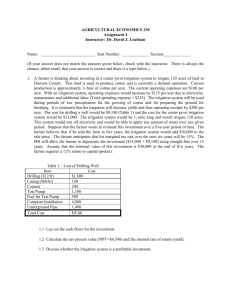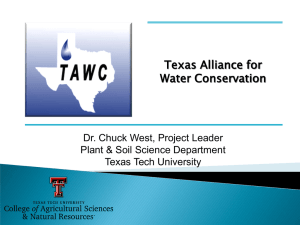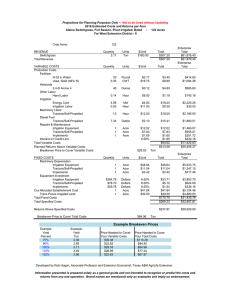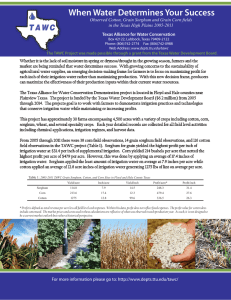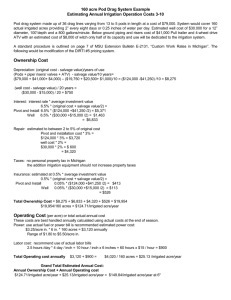ENERGY AND CARBON: CONSIDERATIONS FOR HIGH PLAINS COTTON
advertisement
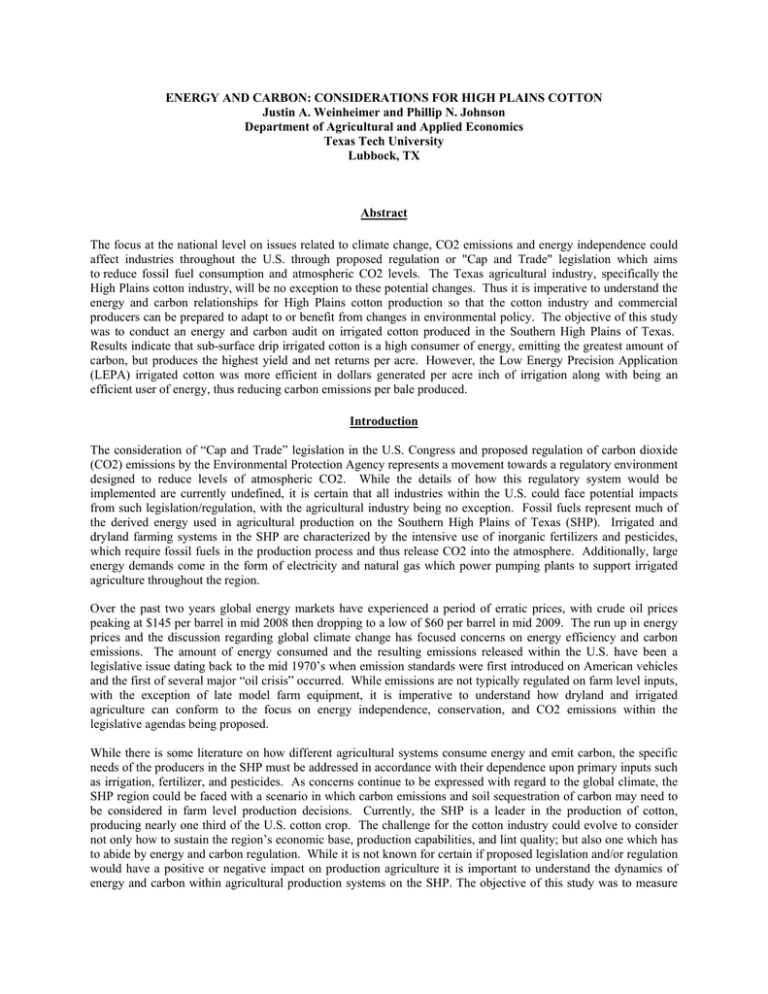
ENERGY AND CARBON: CONSIDERATIONS FOR HIGH PLAINS COTTON Justin A. Weinheimer and Phillip N. Johnson Department of Agricultural and Applied Economics Texas Tech University Lubbock, TX Abstract The focus at the national level on issues related to climate change, CO2 emissions and energy independence could affect industries throughout the U.S. through proposed regulation or "Cap and Trade" legislation which aims to reduce fossil fuel consumption and atmospheric CO2 levels. The Texas agricultural industry, specifically the High Plains cotton industry, will be no exception to these potential changes. Thus it is imperative to understand the energy and carbon relationships for High Plains cotton production so that the cotton industry and commercial producers can be prepared to adapt to or benefit from changes in environmental policy. The objective of this study was to conduct an energy and carbon audit on irrigated cotton produced in the Southern High Plains of Texas. Results indicate that sub-surface drip irrigated cotton is a high consumer of energy, emitting the greatest amount of carbon, but produces the highest yield and net returns per acre. However, the Low Energy Precision Application (LEPA) irrigated cotton was more efficient in dollars generated per acre inch of irrigation along with being an efficient user of energy, thus reducing carbon emissions per bale produced. Introduction The consideration of “Cap and Trade” legislation in the U.S. Congress and proposed regulation of carbon dioxide (CO2) emissions by the Environmental Protection Agency represents a movement towards a regulatory environment designed to reduce levels of atmospheric CO2. While the details of how this regulatory system would be implemented are currently undefined, it is certain that all industries within the U.S. could face potential impacts from such legislation/regulation, with the agricultural industry being no exception. Fossil fuels represent much of the derived energy used in agricultural production on the Southern High Plains of Texas (SHP). Irrigated and dryland farming systems in the SHP are characterized by the intensive use of inorganic fertilizers and pesticides, which require fossil fuels in the production process and thus release CO2 into the atmosphere. Additionally, large energy demands come in the form of electricity and natural gas which power pumping plants to support irrigated agriculture throughout the region. Over the past two years global energy markets have experienced a period of erratic prices, with crude oil prices peaking at $145 per barrel in mid 2008 then dropping to a low of $60 per barrel in mid 2009. The run up in energy prices and the discussion regarding global climate change has focused concerns on energy efficiency and carbon emissions. The amount of energy consumed and the resulting emissions released within the U.S. have been a legislative issue dating back to the mid 1970’s when emission standards were first introduced on American vehicles and the first of several major “oil crisis” occurred. While emissions are not typically regulated on farm level inputs, with the exception of late model farm equipment, it is imperative to understand how dryland and irrigated agriculture can conform to the focus on energy independence, conservation, and CO2 emissions within the legislative agendas being proposed. While there is some literature on how different agricultural systems consume energy and emit carbon, the specific needs of the producers in the SHP must be addressed in accordance with their dependence upon primary inputs such as irrigation, fertilizer, and pesticides. As concerns continue to be expressed with regard to the global climate, the SHP region could be faced with a scenario in which carbon emissions and soil sequestration of carbon may need to be considered in farm level production decisions. Currently, the SHP is a leader in the production of cotton, producing nearly one third of the U.S. cotton crop. The challenge for the cotton industry could evolve to consider not only how to sustain the region’s economic base, production capabilities, and lint quality; but also one which has to abide by energy and carbon regulation. While it is not known for certain if proposed legislation and/or regulation would have a positive or negative impact on production agriculture it is important to understand the dynamics of energy and carbon within agricultural production systems on the SHP. The objective of this study was to measure the relationships of energy and carbon within different irrigation systems using data from the Texas Alliance for Water Conservation project (TAWC, 2008). Additional comparisons were made regarding profitability and irrigation efficiency for each system Methods and Materials This section will be broken into two major categories in correspondence to the major components of the study objectives. The first section discusses the methods to estimate the energy used within each cotton production system and the second section discusses the estimation of carbon emissions. Energy inputs are typically categorized as direct, indirect, and embedded. Use of fuel for irrigation and mechanical operations within the production process is considered a direct energy input. Energy required to manufacture inputs such as fertilizers and chemicals is considered an indirect energy input. Embedded energy is categorized as energy required in manufacturing capital assets used on the farm, such as machinery, equipment, and irrigation systems. In this study, only direct and indirect energy were considered. There are several methods of analyzing energy in agricultural production systems including statistical, input-output analysis, and process analysis (Fluck and Baird 1980). Each is either considered a measure of efficiency, how well energy is converted, or intensity which involves a macro-analysis of the industry as a whole. Both the process method and the input-output analysis are generally applied to the study of energy efficiency, while the statistical method is used to measure energy use intensity. Bullard et al. (1976) indicated that the process analysis is more suited to specific processes, products or manufacturing chains in which the flow of goods and services can be easily traced. In this study the process analysis method was chosen due to the suitability of this method to farm level analysis of production systems. This method is preferred when there is sufficient data available to fully understand the farm practices, operational methods, input quantities, and yield characteristics over several crops and or production systems. Energy coefficients (expressed as mega-joules (MJ)/unit) were established for all inputs, and calculated based on the quantity of inputs used. Energy budgets were developed so that the amount of energy required by each system can be compared with profitability and production practice as well as irrigation efficiency. The energy coefficients for the various inputs were obtained from a number of sources which included Pimentel (1980), Fluck and Baird (1980), and Green (1987). The data available for this study encompasses all aspects of the production system through individual producer records obtained from the Texas Alliance for Water Conservation project, which represent 26 farm sites in Floyd and Hale Counties in the central SHP. Data for this study was collected from 102 cotton production field level observations from the 2005 through 2008 cropping seasons. The cotton production systems analyzed were based on irrigation systems that included subsurface drip (SDI), low energy precision application pivot (LEPA), midelevation spray application pivot (MESA), low elevation spray application pivot (LISA), and conventional furrow irrigation (CF). The direct energy values are the summation of energy consumed in field operations, harvest, processing, and irrigation. In the case of field operations and harvest, the direct energy values represent the amount of diesel fuel consumed in the various mechanical operations. Processing or ginning includes the electricity and fuel used to transport and gin the seed cotton. Energy used in irrigation was calculated assuming electricity as the primary fuel source. Indirect energy calculations consisted of the energy used to manufacture and transport production inputs such as fertilizer and chemicals including harvest aids, herbicides, insecticides and seed production. The energy coefficients, particularly those for nitrogen fertilizer, are primarily driven by the amount of natural gas required in the production process. Similar to the energy coefficients, carbon emissions of inputs were estimated using previously documented values according to the quantity of input used. In this process, field level inputs were broken down into several major categories such as fuel, fertilizer, and electricity with each category having an average carbon equivalent derived from Lal (2004). These generalized carbon equivalents were then applied to the gross quantity of each input used within the specific field budget. The resulting value represents the total carbon emitted resulting from the use or consumption of an input category. Through similar methodology as the energy calculations, carbon emissions were expressed as direct, indirect, and total carbon emissions on a per acre basis. Discussion and Results The results of the energy and carbon audits for cotton by irrigation system are summarized in Table1. The economic results for each irrigation system are given in Table 2. Efficiency measures for irrigation, energy and carbon are given in Table 3. While energy and carbon estimates are the primary focus of this paper, it is also important to consider economic and irrigation measures in the assessment of the different production systems. Relatively high efficiency across the economic, irrigation, energy and carbon measures would indicate that a particular production system may be preferred. Table 1. Energy and Carbon Summary by Irrigation System SDI LEPA MESA LESA CF Yield (bales/acre) 3.59 2.64 2.65 2.85 2.37 Acre Inches Applied 15.5 9.7 11.5 10.8 11.6 Direct Energy/acre 4668.1 3504.2 (MJ) 3687.9 3729.1 3847.4 Indirect Energy/acre 6340.2 4639.9 4638.8 5642.0 3525.1 Total Energy 11008.3 8144.0 8326.7 9371.1 7372.5 Direct Carbon/acre 201.2 140.2 (LBS) 144.3 156.0 158.0 Indirect Carbon/acre 239.7 132.5 134.0 136.7 117.2 Total Carbon 441.0 272.7 278.3 292.7 275.2 As shown in Table 1, the SDI system exhibited the highest average yield of 3.59 bales per acre which was 26% higher than the next highest yielding production system. The furrow irrigated system (CF) had the lowest average yield of 2.37 bales per acre. All sprinkler irrigated systems showed similar yields with water application rates ranging from 9.7 to 11.5 inches per acre. The amount of irrigation applied for the SDI system was the highest at 15.5 acre inches. Irrigation application rates for the other systems ranged from 9.7 acres inches for the LEPA system to 11.6 acre inches for the CF system. Total energy varied from a high of 11008.3 MJ per acre for the SDI system to 7372.5 MJ per acre for the CF system. The SDI system had the highest level of direct energy use at 6340.2 MJ, most of which was due to the level of irrigation applied, and the harvest and ginning processes. The LESA system had the highest level of indirect energy use for the sprinkler irrigation systems at 5642.0 MJ which was related to higher levels of fertilizer application. Since carbon emissions are related to the quantity or energy consumed on an input level it is logical that carbon emissions would follow a similar pattern to energy consumption. Much as with the energy, carbon emissions per acre were the highest for the SDI system at 441.0 lbs per acre and lowest for the CF system at 275.2 lbs per acre. The SDI system was higher in both the direct and indirect carbon emissions due primarily to the high levels of irrigation and nitrogen application. The levels of carbon emissions are similar for the LEPA, MESA, LESA and CF systems. Table 2 presents an economic summary for each irrigation system. The SDI system had the highest gross revenue, gross margin, and net returns at $1,139, $344 and $222, respectively. The higher returns for the SDI system were primarily due to having the highest lint yield at 3.59 bales per acre. However, the higher level of production for the SDI system required higher levels of inputs; therefore, this system also had the highest total costs per acre of $917. The sprinkler irrigation systems along with the furrow system were similar in terms of total production costs per acre, ranging from $630 for the LEPA system to $704 for the LESA system. However, the yields for the sprinkler irrigation systems over the CE system gave the sprinkler systems an advantage in terms of gross margin, ranging from $203 to $295 per acre. While the SDI system had the highest net returns per acre at $222, the higher fixed cost associated with the investment in the SDI system reduced its advantage over the sprinkler irrigation systems. Table 2. Economic Summary by Irrigation System SDI LEPA MESA LESA CF Gross Revenue 1138.9 803.6 ($/Acre) 899.9 888.0 760.1 Pre Harvest Cost 434.9 312.5 335.4 346.0 322.6 Harvest Cost 345.4 225.0 258.7 264.3 223.2 Total Variable Cost 795.2 548.2 605.0 622.2 557.0 Gross Margin 343.6 255.4 295.0 265.8 203.1 Fixed Cost 123.8 83.3 84.1 81.5 77.5 Total Cost 917.1 630.4 689.0 703.7 634.5 Net Returns 221.7 173.2 210.9 184.3 125.6 The efficiency measures given in Table 3 allow for the comparison of each production system from an economic, production, energy and carbon standpoint. Gross margin was the highest for the SDI system at $344 per acre giving it a 17% advantage over the next highest system (MESA) at $266 per acre. Water use efficiency as measured by pounds of lint per acre inch of irrigation applied varied from 130.2 lbs per acre inch for the LEPA system to 97.8 lbs per acre inch for the CF system. While the SDI system had the highest yield, its water use efficiency was comparable to the MESA system which was the least efficient sprinkler irrigation system. With respect to gross margin generated for each acre inch of irrigation water applied, the LEPA system had the highest return at $26 per acre inch. The MESA and LESA systems were similar to the LEPA system with the CF system returning the least amount of gross margin per inch applied at $17. The results indicate that the SDI and LEPA systems were the most efficient in terms of energy use per bale at 3067.3 MJ and 3090.0 MJ, respectively. However the other systems were very similar for this measure ranging from 3106.5 MJ to 3288.9 MJ per bale. The resulting carbon emissions for each system indicated that the SDI system is the least efficient in terms of carbon emissions while the sprinkler systems are similar in their carbon impact. Table 3. Effciency Measures by Irrigation System SDI LEPA MESA LESA CF Gross Margin ($/acre) 343.6 255.4 295.0 265.8 203.1 Irrigation (lbs/inch) 110.8 130.2 111.0 126.7 97.8 Gross Margin ($/inch) 22.1 26.3 25.7 24.6 17.4 Energy (MJ/bale) 3067.3 3090.0 3143.6 3288.9 3106.5 Carbon (lbs/bale) 122.9 103.5 105.1 102.7 116.0 Conclusions The objective of this study was to investigate the energy and carbon relationships in addition to profitability of irrigation technologies being used to produce cotton on the SHP. While the values for energy, carbon, and profitability are relevant, an ideal system would perform well for all measures. It appears that while the SDI system generates the highest revenues per acre, the LEPA system tends to be the most efficient in all other measures of efficiency. Over the time horizon evaluated the LEPA system tended to produce the highest returns per inch of irrigation for both yield and gross margin. In addition, the LEPA system generated relatively lower energy and carbon impacts per bale of cotton produced. While it appears that LEPA technology may be the most efficient in four out of the five efficiency measures evaluated, the SDI system may have the most potential. This is a relatively new technology and the ability to manage the SDI systems to their full potential may still be an option, as producers continue to learn how to best use this new irrigation technology. As the legislative and regulatory process continues with regard to carbon emissions, groundwater supplies continue to decline, and input costs rise, irrigated cotton production across the SHP will require intensive management decisions. It should be noted that the carbon emission values presented in this paper only account for the direct and indirect emission from the production inputs at the field level and do not account for the overall “carbon footprint.” Carbon sequestration in the soil through plant residue is being evaluated to help determine what the net “carbon footprint” is for each production system. References Bullard, C.W., Penner, P.S., and Pilati, D.A., Energy analysis: handbook for combining process and input-output analysis, Center For Advanced Computation, University of Illinois, Urbana, 1976. Fluck, R.C.; Baird, C.C. Agriculture Energetics. Gainesville: University of Florida, Agricultural Engineering Department, Institute of Food and Agricultural Sciences, 1982.197p. Green, M.B. 1987. Energy in pesticide manufacture, distribution and use. In Energy in Plant Nutrition and Pest Control, ed. Z.R. Helsel, 165-177. Amsterdam, The Netherlands: Elsevier. Johnson, J.W., J. Yates, and J. Smith. “Impacts of Increased Energy Costs on Lease Agreements for Irrigated Cotton in the Southern High Plains of Texas.” 2006 Beltwide Cotton Conferences, San Antonio, TX, January 6, 2006. Lal R. “Carbon emissions from farm operations” Environment International, 2004 -9:30(7):981-990. National Agricultural Statistics Service. Various Issues: Agricultural http://www.nass.usda.gov/QuickStats. http://www.usda.gov/nass/pubs/agstats.htm Statistics Data Base. Pimentel, D., 1980, Handbook of Energy Utilization in Agriculture: CRC press: Boca Raton, FL, 475 p. Texas Alliance for Water Conservation (TAWC), 2nd Annual Report, An Integrated Approach to Water Conservation for Agriculture in the Texas Southern High Plains. http://www.gis.ttu.edu/tawc/. Unpublished, 2007. Weinheimer , J and Johnson, J. “Energy Analysis of Cotton Production in the Southern High Plains of Texas.” 2008 Beltwide Cotton Conferences, Nashville TN.
